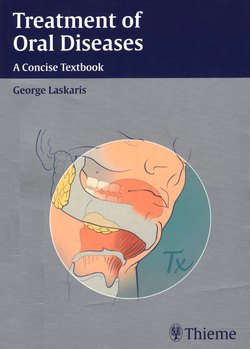Читать книгу Treatment of Oral Diseases - George Laskaris - Страница 13
ОглавлениеAdenocarcinomas of the Salivary Glands
Definition
Salivary gland adenocarcinomas constitute a relatively rare group of oral malignancies originating from the epithelium of the major or minor salivary glands.
Etiology
The etiology of adenocarcinomas of the salivary glands is unknown.
Classification
•Mucoepidermoid carcinoma
•Adenoid cystic carcinoma
•Malignant pleomorphic adenoma
•Acinic cell adenocarcinoma
•Clear cell adenocarcinoma
•Polymorphous low-grade adenocarcinoma
•Adenocarcinoma not otherwise specified
•Epithelial-myoepithelial carcinoma
•Other types
Main Clinical Features
The box gives the clinical features of minor salivary gland malignant neoplasms only.
•Slow-growing, usually painless, rubbery swelling
•Tumor may be slightly mobile and may ulcerate later
•Size progressively increases and pain may develop during the late stages
•Soft palate, buccal mucosa, and upper lip are the most commonly affected sites
•Clinical features are not characteristic and diagnostic
Diagnosis
The clinical diagnosis should be confirmed by biopsy and histopathologic examination.
Differential Diagnosis
•Different types of malignant salivary gland tumor
•Pleomorphic adenoma
•Monomorphic adenoma
•Mucocele
•Necrotizing sialadenometaplasia
•Non-Hodgkin lymphoma
•Malignant granuloma
•Squamous cell carcinoma
•Sarcomas
Treatment
Basic Guidelines
•Before treatment a full clinical examination and laboratory investigations should be done.
•The treatment depends on the grade and stage of each tumor.
•A follow-up program is necessary as recurrences and metastasis are relatively common.
•Details of the surgical procedures are beyond the scope of this book.
Suggested Therapies
•Radical surgical excision is the treatment of choice in all types of malignant salivary gland neoplasms.
•Postoperative radiation therapy may also be used as adjuvant therapy in advanced and aggressive neoplasms.
References
Bensdoum RJ, Allavena C, Chauvel P, et al. 2003 update of standards, options and recommendations for radiotherapy for patients with salivary gland malignant tumors. Cancer Radiother 2003;7:280–295.
Brandwein MS, Ivanov K, Wallace DI, et al. Mucoepidermoid carcinoma: a clinicopalhologic study of 80 patients with special reference to histological grading. Am J Surg Pathol 2001;25:835–845.
Caccamese JF, Ord RA, Paediatric mucoepidermoid carcinoma of the palate, int J Oral Maxillofac Surg 2002;31:136–139.
Castle JT, Thompson LD, Frommelt RA, et al. Polymorphous low grade adenocarcinoma: a clinicopathologic study of 164 cases. Cancer 1999;6:207–219.
Darling MR, Schneider JW, Phillips VM. Polymorphous low-grade adenocarcinoma and adenoid cystic carcinoma: a review and comparison of immunohistochemical markers. Oral Oncol 2002;38:641–645.
Laskaris G. Color Atlas of Oral Diseases. 3rd edition. Thieme Verlag: Stuttgart, 2003.
Neville BW, Damm DD, Allen CM, Bouquot JE. Oral and Maxillofacial Pathology, 2nd edition. WB Saunders Co.: Philadelphia, 2002.
